Ben Murphy is farming a 200-cow split-calving herd just outside Cork city. The herd is split into 120 spring-calvers and 80 autumn-calvers. Ben explained his reasoning for investing €148,000 in a new calf house.
“We got caught with TB a few years ago, which really put us under pressure from an accommodation point of view. I also prefer to sell a strong calf to customers, even as far as selling calves when they are on once-a-day feeding. It suits part-time farmers that can come in and feed calves in the evening after work, and I gain repeat customers that way.’’
As well as this, calf care was taking a similar length of time as it was to milk cows. “We were spending two to two-and-a-half hours at cows, and two hours feeding calves morning and evening.’’
To reduce the workload, Ben opted to install a JFC robotic feeder to complement the new calf house with four feed stations. The shed is a five-bay double, with standard 4.8m bays, measuring 17m wide. An additional two bays are situated at the top of the shed for the nursery and storage stations.
Ben opted to install 18 individual calf pens for newborn calves.
With many farmers opting away from individual pens, Ben explained: “When operating alone, I wanted to be sure that each calf, for the first week, was drinking properly and that there were no issues with them.’’
Individual pens, sourced from O’Donovan Engineering, are fitted with plastic slats which Ben then beds with straw.
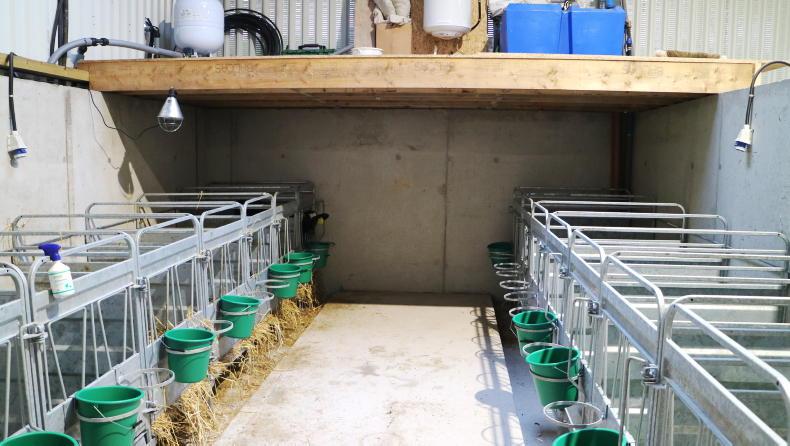
Ben fitted 18 individual calf pens. The loft area is used to store the washdown pump, water heater and the aqua box, as well as providing additional shelter for weaker calves.
The central passageway is raised, with the concrete underneath the pens sloped back into effluent channels that run through to a tank.
In this section, Ben has installed a loft area to house the washdown pump that utilises water from a rainwater harvesting system, the electric water heater and the aqua box for the JFC feeder.
The loft covers six of the individual pens, which Ben plans on using for the weaker calves that might require additional shelter. One of two secondhand fire hose reels are available in this area to allow for ease of washing, with the central passage sloped to each side towards the effluent channels running underneath the pens.
Adjacent to the nursery area is a storage area. Milk replacer, straw and concentrates are stored here, though it can be used as an overflow for calves, if needed. The storage area is directly opposite a large sliding door to allow forklifts or tractors to easily drop supplies in.
A large stainless-steel sink is also situated here to allow for teat feeders to be washed in peracetic acid for hygiene.

A whiteboard is fixed to the front of the storage area alongside all the controls for pumps and fuses. A thermometer is fitted beside the hand towel dispenser to monitor temperature within the shed.
A hand-washing basin is fitted to the front, as well as a whiteboard for detailing standard operating procedure (SOP) to be recorded, sick calves, etc, as well as a thermometer to monitor the internal shed temperature.
“With it being a new shed with plenty of ventilation, I was conscious of calves being cold,’’ stated Brian.
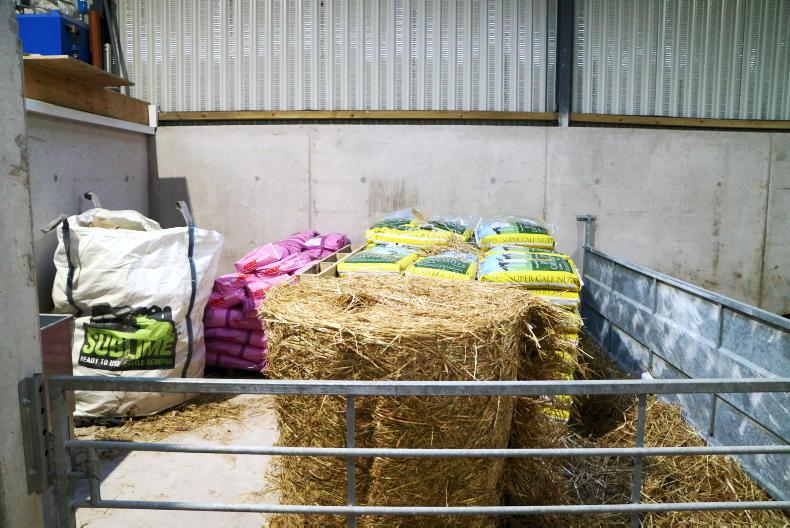
The storage area is located directly across from a sliding door, with a sheeted gate to prevent draughts on calves in the next pen.
Despite it being a blustery midwinter day when the Irish Farmers Journal visited, the autumn-born calves were lying throughout the pen, where historically Ben stated that calves would be found lying against the wall due to draughts in the old shed.
After a week in individual boxes, calves will transition to one of four straw-bedded pens, where Ben will feed them with teat feeders using a JFC teat for a further week.
Ben has a target of eight to 10 calves per pen with each pen 17.6m2, allowing a space of approximately 1.8m2 per calf.
Floors are sloped down from the back of the pen at a 1:15 gradient, with an effluent channel running along the barrier.
Similar to the nursery area, the central passage is raised 150mm above the pens to allow a buildup of straw and to prevent effluent escaping.
Pedestrian gates allow Ben to easily access the pens, while locating the water trough at the front means that any spillages or leaks are caught by the effluent channel.
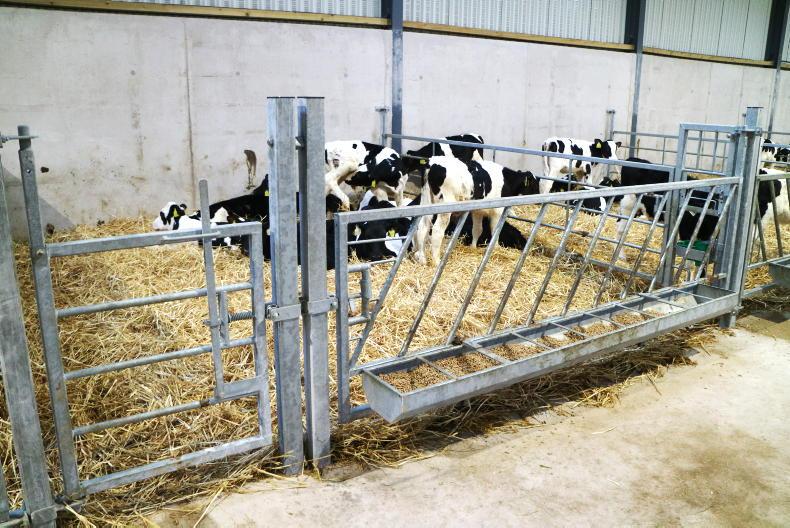
Pedestrian gates are fitted to each pen.
A large sliding door gives access for cleaning out using a telehandler or tractor and loader.
Automatic calf feeder area
At two weeks of age, calves will be switched on to the automatic calf feeder. Ben has created three large pens to one side of the shed, each measuring 67m2 and fitted with its own feed station. The front half of this area is covered in plastic slats.

Each of the feed stations is slatted for hygiene purposes.
“Originally, I had been looking for concrete slats, but O’Donovans had plastic slats for sheep sheds in stock. If a calf has a large feed of milk and goes to lie on them, at least they will be warmer than lying on concrete.’’
A 1.2m deep tank was installed across the five bays, extending out to the end of the shed for agitation.
Each feed station is also slatted and channelled towards the tank, as Ben saw this area as being hard to keep clean on other farms. A kerb is to be installed to separate the bedded and slatted areas, with a 1:15 slope again installed in the bedded area, sloping towards the tank.
Both this bedded area and the transition area were power floated for a smooth finish, to allow ease of washing down. The second fire hose reel for washing down is located beside a small training area fitted with its own feed station.
A pedestrian gate allows ease of access to push calves up to the feeder.

Effluent channels run at the front of bedded pens.

A new calf shed built on the farm of Ben Murphy, Knockcraha, Co Cork. The two bays on the left make up the nursery and storage stations.
Other key features
Vented sheeting is used along the sides, as well as a 450mm overhang with a gap under the eaves to allow for adequate air intake. A central ridge opening fitted with a canopy acts as an air outlet.
Three sliding doors are fitted, with the door facing the prevailing wind extended beyond the shed to prevent draughts.

Two secondhad fire hose reels are used for washing down the house, powered by a pump that uses rainwater.
Cement fibre sheeting was used as it came in €2,000 cheaper than steel sheeting and Ben wanted to reduce dripping on calves.
High-bay beam lights are fitted for working out of daylight hours.
In Ben’s own admission, the build came in at a higher cost than expected, but he is extremely pleased at the finish and layout of the shed. Including the calf feeder from JFC, total costs are €148,000 plus VAT. Ben did much of the work himself, including building the effluent tank with blocks and much of the concrete work, which helped reduce costs. TAMS aid was sought for the automatic calf feeder, which came in at €16,000 plus VAT.
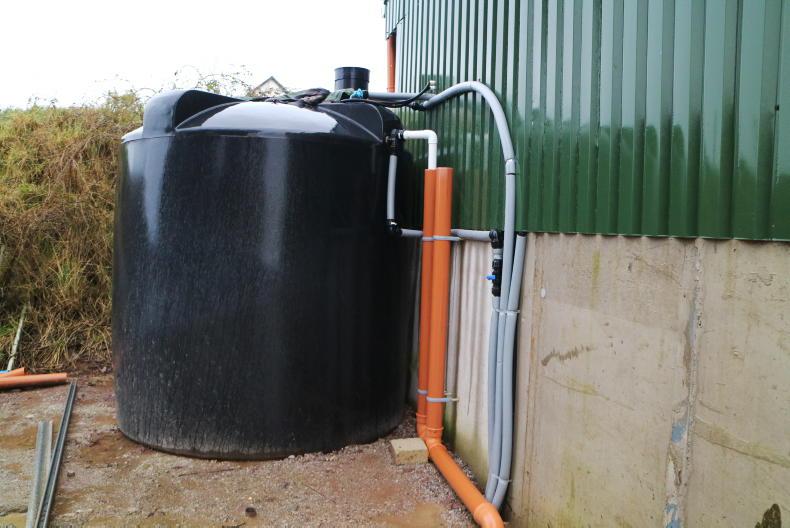
The rainwater harvesting tank was installed and fitted with a pump to be used for washing down the calf shed.
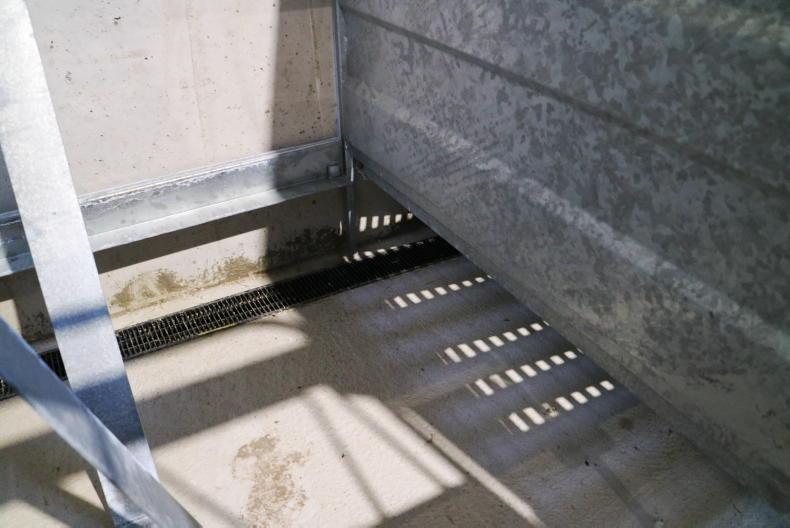
Effluent channels run underneath the individual calf pens.
Ben hopes that the new build will halve the time spent feeding calves to one hour, which it should do. The layout is impressive, with plenty of ventilation and effluent channels fitted.
Ben was very conscious of slopes on floors and finishing of concrete for ease of cleaning which shone through in the end. A pragmatic approach on calf housing, like Ben has taken, in light of the uncertainty of moving calves at a young age, should be taken up by more farmers.
Ben Murphy is farming a 200-cow split-calving herd just outside Cork city. The herd is split into 120 spring-calvers and 80 autumn-calvers. Ben explained his reasoning for investing €148,000 in a new calf house.
“We got caught with TB a few years ago, which really put us under pressure from an accommodation point of view. I also prefer to sell a strong calf to customers, even as far as selling calves when they are on once-a-day feeding. It suits part-time farmers that can come in and feed calves in the evening after work, and I gain repeat customers that way.’’
As well as this, calf care was taking a similar length of time as it was to milk cows. “We were spending two to two-and-a-half hours at cows, and two hours feeding calves morning and evening.’’
To reduce the workload, Ben opted to install a JFC robotic feeder to complement the new calf house with four feed stations. The shed is a five-bay double, with standard 4.8m bays, measuring 17m wide. An additional two bays are situated at the top of the shed for the nursery and storage stations.
Ben opted to install 18 individual calf pens for newborn calves.
With many farmers opting away from individual pens, Ben explained: “When operating alone, I wanted to be sure that each calf, for the first week, was drinking properly and that there were no issues with them.’’
Individual pens, sourced from O’Donovan Engineering, are fitted with plastic slats which Ben then beds with straw.

Ben fitted 18 individual calf pens. The loft area is used to store the washdown pump, water heater and the aqua box, as well as providing additional shelter for weaker calves.
The central passageway is raised, with the concrete underneath the pens sloped back into effluent channels that run through to a tank.
In this section, Ben has installed a loft area to house the washdown pump that utilises water from a rainwater harvesting system, the electric water heater and the aqua box for the JFC feeder.
The loft covers six of the individual pens, which Ben plans on using for the weaker calves that might require additional shelter. One of two secondhand fire hose reels are available in this area to allow for ease of washing, with the central passage sloped to each side towards the effluent channels running underneath the pens.
Adjacent to the nursery area is a storage area. Milk replacer, straw and concentrates are stored here, though it can be used as an overflow for calves, if needed. The storage area is directly opposite a large sliding door to allow forklifts or tractors to easily drop supplies in.
A large stainless-steel sink is also situated here to allow for teat feeders to be washed in peracetic acid for hygiene.

A whiteboard is fixed to the front of the storage area alongside all the controls for pumps and fuses. A thermometer is fitted beside the hand towel dispenser to monitor temperature within the shed.
A hand-washing basin is fitted to the front, as well as a whiteboard for detailing standard operating procedure (SOP) to be recorded, sick calves, etc, as well as a thermometer to monitor the internal shed temperature.
“With it being a new shed with plenty of ventilation, I was conscious of calves being cold,’’ stated Brian.

The storage area is located directly across from a sliding door, with a sheeted gate to prevent draughts on calves in the next pen.
Despite it being a blustery midwinter day when the Irish Farmers Journal visited, the autumn-born calves were lying throughout the pen, where historically Ben stated that calves would be found lying against the wall due to draughts in the old shed.
After a week in individual boxes, calves will transition to one of four straw-bedded pens, where Ben will feed them with teat feeders using a JFC teat for a further week.
Ben has a target of eight to 10 calves per pen with each pen 17.6m2, allowing a space of approximately 1.8m2 per calf.
Floors are sloped down from the back of the pen at a 1:15 gradient, with an effluent channel running along the barrier.
Similar to the nursery area, the central passage is raised 150mm above the pens to allow a buildup of straw and to prevent effluent escaping.
Pedestrian gates allow Ben to easily access the pens, while locating the water trough at the front means that any spillages or leaks are caught by the effluent channel.

Pedestrian gates are fitted to each pen.
A large sliding door gives access for cleaning out using a telehandler or tractor and loader.
Automatic calf feeder area
At two weeks of age, calves will be switched on to the automatic calf feeder. Ben has created three large pens to one side of the shed, each measuring 67m2 and fitted with its own feed station. The front half of this area is covered in plastic slats.

Each of the feed stations is slatted for hygiene purposes.
“Originally, I had been looking for concrete slats, but O’Donovans had plastic slats for sheep sheds in stock. If a calf has a large feed of milk and goes to lie on them, at least they will be warmer than lying on concrete.’’
A 1.2m deep tank was installed across the five bays, extending out to the end of the shed for agitation.
Each feed station is also slatted and channelled towards the tank, as Ben saw this area as being hard to keep clean on other farms. A kerb is to be installed to separate the bedded and slatted areas, with a 1:15 slope again installed in the bedded area, sloping towards the tank.
Both this bedded area and the transition area were power floated for a smooth finish, to allow ease of washing down. The second fire hose reel for washing down is located beside a small training area fitted with its own feed station.
A pedestrian gate allows ease of access to push calves up to the feeder.

Effluent channels run at the front of bedded pens.

A new calf shed built on the farm of Ben Murphy, Knockcraha, Co Cork. The two bays on the left make up the nursery and storage stations.
Other key features
Vented sheeting is used along the sides, as well as a 450mm overhang with a gap under the eaves to allow for adequate air intake. A central ridge opening fitted with a canopy acts as an air outlet.
Three sliding doors are fitted, with the door facing the prevailing wind extended beyond the shed to prevent draughts.

Two secondhad fire hose reels are used for washing down the house, powered by a pump that uses rainwater.
Cement fibre sheeting was used as it came in €2,000 cheaper than steel sheeting and Ben wanted to reduce dripping on calves.
High-bay beam lights are fitted for working out of daylight hours.
In Ben’s own admission, the build came in at a higher cost than expected, but he is extremely pleased at the finish and layout of the shed. Including the calf feeder from JFC, total costs are €148,000 plus VAT. Ben did much of the work himself, including building the effluent tank with blocks and much of the concrete work, which helped reduce costs. TAMS aid was sought for the automatic calf feeder, which came in at €16,000 plus VAT.

The rainwater harvesting tank was installed and fitted with a pump to be used for washing down the calf shed.

Effluent channels run underneath the individual calf pens.
Ben hopes that the new build will halve the time spent feeding calves to one hour, which it should do. The layout is impressive, with plenty of ventilation and effluent channels fitted.
Ben was very conscious of slopes on floors and finishing of concrete for ease of cleaning which shone through in the end. A pragmatic approach on calf housing, like Ben has taken, in light of the uncertainty of moving calves at a young age, should be taken up by more farmers.
















 This is a subscriber-only article
This is a subscriber-only article











SHARING OPTIONS: